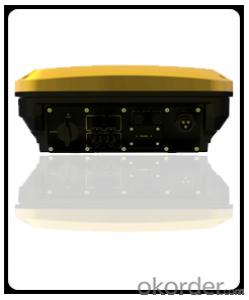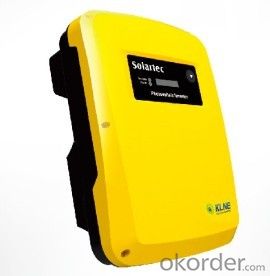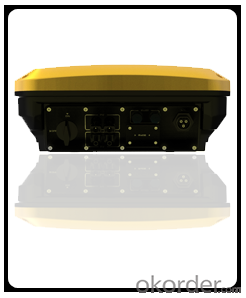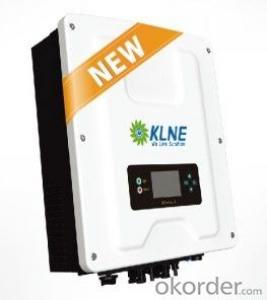36 Volt Solartec 1500 On Grid Inverter with WiFi
- Loading Port:
- Shanghai
- Payment Terms:
- TT OR LC
- Min Order Qty:
- -
- Supply Capability:
- 10000 set/month
OKorder Service Pledge
Quality Product, Order Online Tracking, Timely Delivery
OKorder Financial Service
Credit Rating, Credit Services, Credit Purchasing
You Might Also Like
Solartec 1500, 2000,2500,3000,3600,4000,4600,5000 1MPPT, single phase IP 65 New mold with Pure thick aluminum crust. Safe Flexible SimpleEfficient
■ Efficiency of up to 97.6 %
■ Transformerless
■ Integrated DC switch
■ Comprehensive protection functions
■ LCD backlight
■ For indoor and outdoor installation
■ ‘Plug and play’connection for easy installation
■ Friendly interface, easy to install and maintain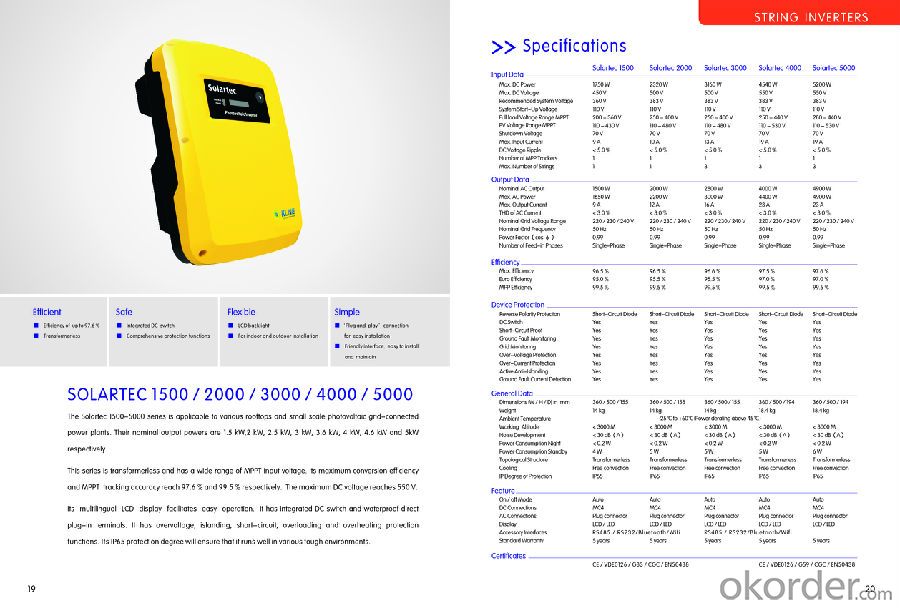
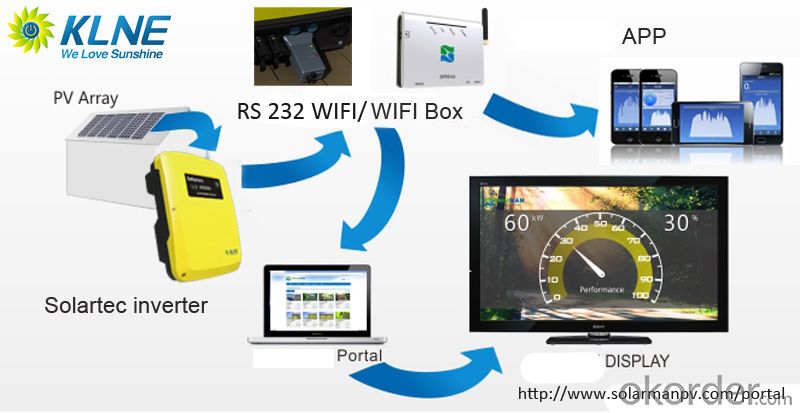
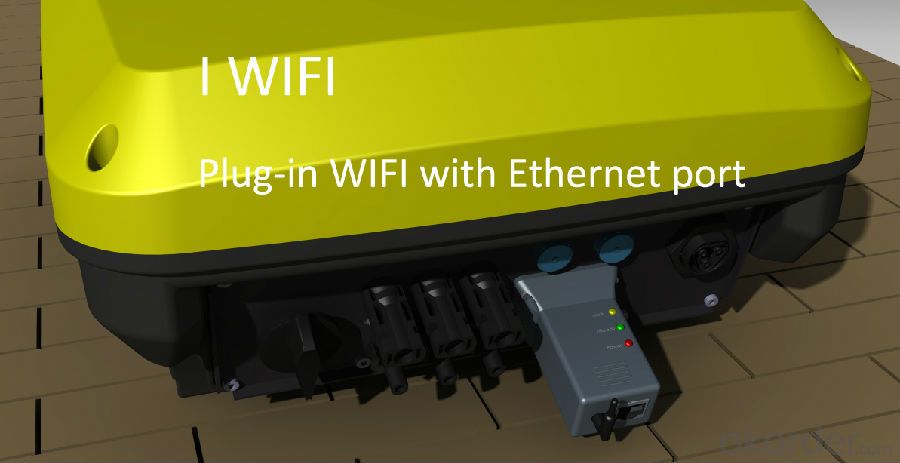
Beijing Kinglong New Energy Technology Co., Ltd.
3rd. floor, Caihong North Building West Entrance, 11 Xinxi Road, Shang Di, Haidian Dist, Beijing, China
T.:+86(0)1062988159-678 M.:+86 1800 1179 441
Skype:klnevivian
Skype:klnevivian
E:vivian@kinglongpower.com
Website: www.kinglongpower.com
- Q: Can a solar inverter be used in conjunction with a backup generator?
- Yes, a solar inverter can be used in conjunction with a backup generator. In fact, this combination is often used in hybrid solar systems to provide continuous power supply even during times of low solar generation or power outages. The solar inverter manages the power flow from both the solar panels and the generator, ensuring a seamless transition between power sources and maximizing the utilization of renewable energy.
- Q: Can I connect solar panels directly to the grid without an inverter?
- No, you cannot connect solar panels directly to the grid without an inverter. An inverter is necessary to convert the DC (direct current) output from solar panels into AC (alternating current) that is compatible with the grid.
- Q: What is the role of a power limiter in a solar inverter system?
- The primary function of a power limiter in a solar inverter system is to regulate the amount of power that is supplied to the grid from the solar panels. When the solar panels produce more power than necessary or permitted by the grid, the power limiter serves as a control mechanism to restrict the amount of power injected into the grid. This control mechanism ensures that the power output from the solar panels remains within the specified limits, preventing any overloading or destabilization of the grid. To achieve this, the power limiter continuously monitors the power output from the solar panels and adjusts it accordingly to meet the grid requirements. It achieves this by intelligently controlling the inverter, which converts the direct current (DC) generated by the solar panels into alternating current (AC) suitable for integration with the grid. By limiting the power fed into the grid, the power limiter plays a crucial role in maintaining the stability of the grid. It helps prevent voltage fluctuations, reduces the risk of power surges or blackouts, and ensures compliance with local regulations and grid codes pertaining to solar power generation. Furthermore, the power limiter can offer additional functionalities such as grid synchronization, anti-islanding protection, and remote monitoring. These additional features enhance the safety, reliability, and overall performance of the solar inverter system. In summary, the inclusion of a power limiter in a solar inverter system is essential for maintaining a balance between power generation and grid stability. It optimizes the use of solar energy and ensures the safe and efficient integration of solar power into the electrical grid.
- Q: Can a solar inverter be used in a three-phase power system?
- Yes, a solar inverter can be used in a three-phase power system. In fact, three-phase solar inverters are commonly used in commercial and industrial applications where three-phase power is utilized. These inverters convert the DC power generated by solar panels into AC power that can be seamlessly integrated into the three-phase power grid.
- Q: Can a solar inverter be used in areas with high levels of electromagnetic interference (EMI)?
- Yes, a solar inverter can be used in areas with high levels of electromagnetic interference (EMI). However, it is important to ensure that the inverter is designed and equipped to handle such conditions. Certain models of solar inverters are specifically designed to mitigate the effects of EMI and provide reliable performance even in challenging electromagnetic environments.
- Q: Can a solar inverter be used with different types of tracking systems?
- Yes, a solar inverter can be used with different types of tracking systems. The function of a solar inverter is to convert the DC (direct current) generated by the solar panels into AC (alternating current) that can be used to power electrical devices. As long as the tracking system is capable of generating DC power from the solar panels, the solar inverter can be used to convert it into usable AC power.
- Q: How does a solar inverter handle fluctuations in solar panel output due to temperature changes?
- A solar inverter handles fluctuations in solar panel output due to temperature changes by incorporating a maximum power point tracking (MPPT) algorithm. This algorithm continuously adjusts the voltage and current levels to optimize the power output from the solar panels, compensating for any temperature-related variations. By dynamically adapting to temperature changes, the solar inverter ensures that the maximum power is extracted from the panels and efficiently converted into usable electricity.
- Q: Can a solar inverter be used in a solar-powered telecommunications system?
- Yes, a solar inverter can be used in a solar-powered telecommunications system. The solar inverter is responsible for converting the direct current (DC) produced by solar panels into alternating current (AC) that can be used to power various devices in the system, including telecommunications equipment.
- Q: What is the role of a fault detection system in a solar inverter?
- The role of a fault detection system in a solar inverter is to monitor and identify any issues or malfunctions within the inverter system. It helps to prevent or minimize downtime by quickly detecting faults such as overvoltage, overcurrent, short circuits, or temperature abnormalities. By promptly identifying and alerting the system operator about these faults, the fault detection system allows for timely maintenance or repairs, ensuring optimal performance and safety of the solar inverter.
- Q: Can a solar inverter be used with a solar-powered cooling system?
- Yes, a solar inverter can be used with a solar-powered cooling system. A solar inverter is responsible for converting the direct current (DC) electricity generated by solar panels into alternating current (AC) electricity that can be used to power various appliances, including cooling systems. By integrating a solar inverter into a solar-powered cooling system, the system can effectively harness solar energy to operate and provide cooling without relying on external power sources.
Send your message to us
36 Volt Solartec 1500 On Grid Inverter with WiFi
- Loading Port:
- Shanghai
- Payment Terms:
- TT OR LC
- Min Order Qty:
- -
- Supply Capability:
- 10000 set/month
OKorder Service Pledge
Quality Product, Order Online Tracking, Timely Delivery
OKorder Financial Service
Credit Rating, Credit Services, Credit Purchasing
Similar products
Hot products
Hot Searches
Related keywords

